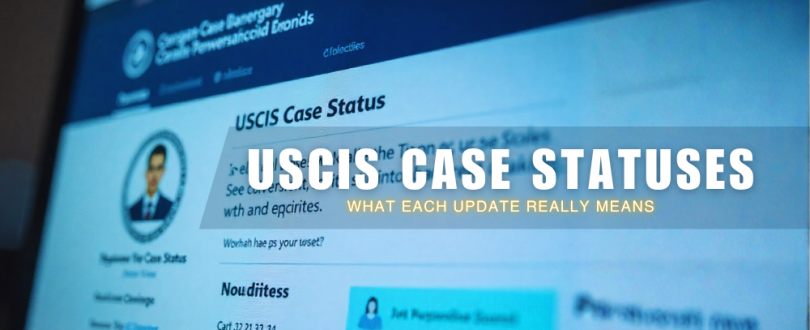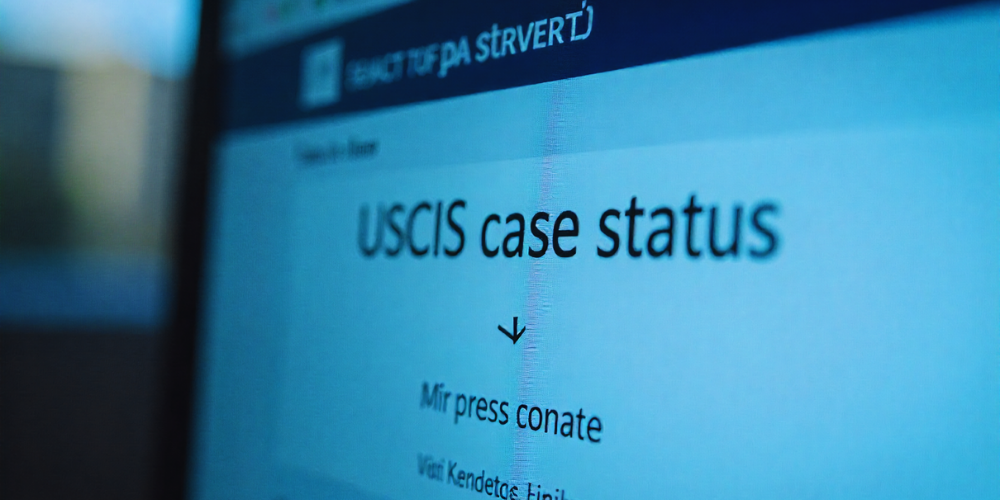
There’s a particular kind of suspense that comes with checking your USCIS case status — that quiet mix of hope, anxiety, and constant refreshes of your browser. Every immigrant knows it: the moment your heart skips as you see a new update, wondering whether it’s good news or a call for more paperwork.
But behind those short, technical phrases like “Case Was Received” or “Request for Evidence Sent” lies the story of your immigration journey. These aren’t just administrative codes; they’re milestones — each one marking progress, pause, or a pivot in your path toward approval.
Understanding what your USCIS case status means can transform the process from confusing to empowering. In this guide, we’ll decode the most common USCIS case statuses, break down what each message actually signifies, and show you exactly how to track them using official tools. Whether you’re waiting on a visa, green card, or work permit, this breakdown will help you read your case like a pro — and breathe a little easier while you wait.
Understanding USCIS Case Statuses
What Is a USCIS Case Status?
A USCIS case status is essentially your immigration application’s “heartbeat” — a real-time update on where your petition stands within the U.S. Citizenship and Immigration Services system. Each status tells you what stage your case has reached, from receipt to review, approval, or decision. Think of it as the government’s way of keeping you in the loop (even if the messages sometimes feel cryptic).
Why It Matters
Knowing your case status isn’t just about curiosity — it’s about control. Each update can signal whether you need to take action, such as submitting documents, preparing for an interview, or simply waiting patiently. Recognizing these cues can save time, reduce stress, and prevent costly delays. It also helps you anticipate what comes next — or spot when something might be off track and needs follow-up.
Where to Find It
Your case status is tied to your USCIS receipt number, a 13-character alphanumeric code printed on your official receipt notice (Form I-797C). With that number, you can check updates through the USCIS Case Status Online tool— the most reliable and current source of information. You can also get updates by phone through the USCIS Contact Center, or by checking your case through official resources like the EOIR Automated Case Information system for immigration court cases.

Common USCIS Case Statuses and Their Meanings
Your USCIS case status is more than a bureaucratic label — it’s a digital breadcrumb trail through the immigration maze. Below are the most common updates you’ll see, what they mean, and what to do (or not do) when they appear.
Case Was Received
Meaning: USCIS has officially received your application or petition, and it’s been entered into the system. This is the “you’re in the queue” moment.
What to Expect: You’ll get a Receipt Notice (Form I-797C) confirming that your package made it safely. No further action is required right now.
Processing Tip: This stage often takes the longest. Depending on your case type, it may sit in processing for weeks or even months before moving forward. Use this time to review your documents and ensure your contact information with USCIS is up to date.
Case Being Actively Reviewed
Meaning: Your application is currently under the watchful eye of a USCIS officer. They’re verifying documents, running background checks, and assessing eligibility.
What to Do: Nothing — at least, not yet. “Actively reviewed” doesn’t always mean constant action; it means your file is in the officer’s workflow. Patience here is key.
Request for Evidence (RFE)
Meaning: USCIS needs additional documents or clarification before proceeding. This might be due to missing forms, incomplete evidence, or questions about eligibility.
What to Do: Respond promptly and thoroughly. Your RFE notice will list what’s needed and the deadline (typically 87 days). Submitting everything correctly the first time can prevent major delays or denials.
Case Is Ready To Be Scheduled For An Interview
Meaning: Your application has passed initial review and is now waiting for an interview slot — often for green card or naturalization applicants.
What to Expect: Interview scheduling depends on local USCIS office workloads. It could take a few weeks to several months.
Pro Tip: Begin preparing now — review your submitted documents, gather originals, and rehearse potential interview questions.
Case Was Reopened
Meaning: USCIS has decided to reopen a previously closed or denied case — often after a motion to reopen or reconsider is approved.
What to Do: Follow the instructions in the reopening notice closely. You may need to submit new evidence or attend an additional interview.
Case Was Closed
Meaning: Your case is no longer being processed. Closures happen for reasons like applicant withdrawal, administrative action, or abandonment (for example, not responding to an RFE).
Next Steps: Carefully read the closure notice. It will explain whether you can appeal, reapply, or if no further action is possible.
Case Was Returned To Department of State
Meaning: If your case involves consular processing, this means your approved petition has been forwarded to the National Visa Center (NVC) or a U.S. consulate abroad.
Next Steps: Monitor your email or mail for instructions from the Department of State. From here, visa interview scheduling and document submission happen through NVC channels.
Case Was Approved
Meaning: Congratulations — your petition or application has been approved!
What Happens Next: Depending on your case, you’ll receive an official approval notice, and soon after, a physical document (like a green card, EAD, or travel document). Keep copies of everything for your records — these papers are your proof of status.
Case Was Denied
Meaning: USCIS determined your application does not meet eligibility requirements.
What to Do: Don’t panic. The denial notice will detail why your case was denied and outline possible next steps — such as appealing, filing a motion to reopen/reconsider, or reapplying with stronger evidence. Consulting an immigration attorney at this stage is highly recommended.
Card or Notice Was Mailed
Meaning: Your approval notice or physical document has been sent out.
Next Steps: Track your mail carefully — USCIS usually provides a USPS tracking number. If your card doesn’t arrive within 30 days, contact USCIS to issue a replacement. Pro tip: sign up for USPS Informed Delivery to monitor incoming government mail.

How To Check Your USCIS Case Status
Online (Primary Method)
1. Go to the USCIS Case Status Online page.
2. Enter your 13-character receipt number (found on your Form I-797C).
3. Click “Check Status.”
You’ll immediately see the most recent update for your application. Bookmark the page — it’s the fastest, most accurate way to stay informed.
By Phone
You can call the USCIS Contact Center at 1-800-375-5283. Have your receipt number ready, and be prepared to verify personal details. This option is best for applicants who need clarification or can’t access the online system.
Official Alternatives
If your case is in immigration court, check the EOIR Automated Case Information system for status updates.
Other reliable tools include government partners such as GovAssist, Boundless, or Docketwise, which offer easy-to-understand interpretations of USCIS codes and notifications.
Tips for Monitoring Your Case Efficiently
Tracking your USCIS case can feel like watching a movie on pause — nothing seems to move until, suddenly, everything does. To stay informed (and sane) during the waiting game, here’s how to monitor your case efficiently and avoid the most common pitfalls.
Keep Your Contact Information Updated
It sounds obvious, but it’s one of the most overlooked steps. A single outdated address or email could mean missing a critical notice — like an interview appointment or a Request for Evidence.
Update your details through your USCIS online account or by filing Form AR-11 (Change of Address) as soon as you move. If you’ve hired an attorney or representative, confirm that both your contact info and theirs are current. USCIS sends updates to the address on record — not necessarily the one you last used.
Interpret Case Updates Correctly
Not every case status change is cause for celebration or alarm. For example, “Case Was Updated to Show Fingerprints Were Taken” is procedural, not a sign of trouble. Similarly, “Case Was Actively Reviewed” may appear multiple times — it doesn’t always mean fresh action.
Avoid concluding online forums or Reddit threads (they’re often anecdotal). Instead, refer to official explanations or trusted immigration resources to understand what your update really means. When in doubt, go back to your USCIS notice — it’s your primary source of truth.
Know When to Contact USCIS or an Immigration Attorney
If your case has been stagnant beyond the posted processing time, or you’ve received confusing or conflicting notices, it’s time to reach out.
You can submit an “outside normal processing time” inquiry through the USCIS website, call the Contact Center, or request an appointment at a USCIS Field Office.
If you receive a denial, RFE, or notice of intent to deny, consulting an experienced immigration attorney can make the difference between a dead end and a successful reapplication.
Remember: knowing when to act — and when to wait — is part of the process.
Conclusion: Stay Informed, Stay Ready
The immigration process can often feel like a long stretch of waiting — equal parts excitement and uncertainty. But understanding your USCIS case status turns that waiting into awareness. Each update, each line of text on your account, is a checkpoint on your journey toward opportunity, security, and belonging.
By learning what those statuses mean, you’re not just following a process — you’re mastering it. You know when to act, when to prepare, and when to pause. That awareness saves time, prevents missteps, and replaces confusion with confidence.
So, stay proactive. Keep your contact details current. Verify every update through official USCIS tools, not social media chatter. And above all — stay patient. Immigration is a marathon, not a sprint, but knowledge is your strongest advantage along the way.
Frequently Asked Questions (FAQ)
1. How long does it take for a USCIS case status to update?
USCIS case statuses don’t always update in real time. Some changes appear within days, while others may take weeks depending on the type of application and workload at the service center. If your case hasn’t updated for several months, check USCIS’s processing times tool or submit an inquiry for cases “outside normal processing time.”
2. What should I do if my case has been “Actively Reviewed” for a long time?
“Actively Reviewed” can last for weeks or even months — it simply means a USCIS officer has your file in the queue. It doesn’t always indicate ongoing daily review. If it’s been significantly longer than your case type’s posted processing time, consider contacting USCIS or speaking with an immigration attorney for advice.
3. I received a “Request for Evidence” (RFE). How do I respond correctly?
Read your RFE notice carefully and gather exactly what USCIS asks for — no more, no less. Send your response before the stated deadline (usually within 87 days) and include a clear cover letter referencing your receipt number. Submitting a complete, organized response increases your chances of approval and avoids unnecessary delays.
4. My case was denied — can I appeal?
In most cases, yes. Your denial notice will specify whether you can file an appeal or a motion to reopen/reconsider. These options must be filed within strict deadlines, typically 30 days from the notice date. If you’re unsure, consult an immigration attorney to determine the best next step based on your case type.
5. Where can I check my USCIS case status safely?
Always use the USCIS Case Status Online tool — the official government source. You’ll need your 13-character receipt number (e.g., WAC1234567890). Avoid unofficial websites or social media pages claiming to predict outcomes — they can’t access your actual case data.

